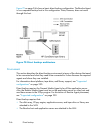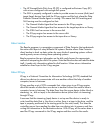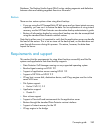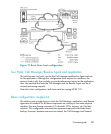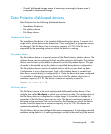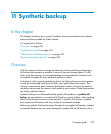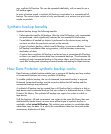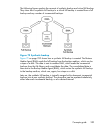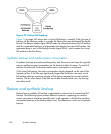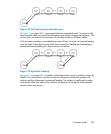Disk backup benefits
There are many situations in which it is advantageous to use disk-based devices when
performing backups. Disk-based devices are, in fact, specific files in specified
directories, to which you can back up data instead of or in addition to backing it up
to tape. The following list indicates some situations in which disk-based devices are
particularly useful:
• Many applications and databases continuously generate or change a large
number of files, which contain business-critical data. Under these circumstances,
it is necessary to continuously back up the files concerned, in order to guarantee
the capability of restoring them without data loss.
In these environments, tape devices typically have to operate in stop/start mode,
because they do not receive a constant data stream. This may result in the tape
device limiting access to the files concerned. In addition, the lifetime of the backup
device may be greatly reduced.
Alternatively backups can be performed to any disk-based device, overcoming
the limitations described. As a short-term backup solution, this is adequate in
itself. If a longer term backup solution is required, the data in the disk-based
devices can be moved periodically to tape to free up the disk space. This process
is known as disk staging.
• In environments that have fast, high-capacity disk drives and slow tape drives,
you can shrink the backup window by performing backup to disk-based devices
first and moving the data to tape later.
• Using disk-based devices for backup enables you to take advantage of advanced
backup strategies such as synthetic backup.
• Disk-based devices are useful for providing fast restore capability for recently
backed up data. For example, backup data could be kept in a disk-based device
for 24 hours to enable fast, convenient restore.
• Mechanically, a disk-based device is quicker to use than a tape. When using a
disk-based device there is no need to mount and unmount a tape. When backing
up or restoring a small amount of data, a disk-based device is quicker because
it does not need the initialization time that a tape drive requires. With a disk-based
device there is no need to load or unload media, which consumes a significant
amount of time in a small backup or restore. The advantages of using a disk-based
device are even more evident when restoring from an incremental backup.
• The risk of media problems such as faulty tapes and tape mounting failures are
reduced to a minimum. The availability of RAID disk configurations provides
protection of data in cases where a disk fails.
• Overhead costs are reduced because there is no need for tape handling.
Disk backup254



